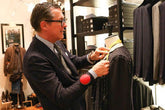
The ‘information age’ as its colloquially referred to, has - paradoxically - become the age of misinformation. This is especially true of menswear, where the word ‘influencer’ has become a synonym for ‘ignoramus’ and the increasingly global nature of manufacturing has conceived innumerable new entrants to the market - most of whom harbour no real knowledge on menswear outside of fetishising their on-screen heroes such as Harvey Specter and James Bond.
Alas, the true nature and quality of many menswear products is often obscured by marketing hyperbole, and to sift through such embellishments and exaggerations has become somewhat akin to splitting the atom. Fear not though, for you’re in good hands here on Michael Jondral’s site! Throughout this article, we shall explore what constitutes a well-made, high quality pair of shoes, and what to look for when making your next purchase.
The Last
By far the most important consideration when purchasing a pair of shoes is the fit. Even the most exquisitely patina'd crocodile loafers will be rendered redundant if they’re unwearable on account of the fit.
For this reason, the ‘last’ the shoe is made on is of paramount importance. If you’re opting for a bespoke commission, then naturally, the last will be made to the exact specifications of your foot and you should - theoretically - incur fewer fit-related issues.
For this reason, those with particularly odd shaped feet will benefit from bespoke. In the realm of RTW and MTO though, a variety of lasts that can accommodate feet of different shapes is a reasonably good barometer as to the overall quality of a shoemaker.
Hand Welted vs Goodyear vs Blake
Subsequent to fit is the manner in which the shoe is constructed - which bears an influence on such things as; breathability, comfort, longevity and aesthetics. While all makers will subscribe to different methodologies with respect to their pricing and market positioning, it’s important to note the differences between them so as to determine if you’re achieving value for money in your purchase. Although not always accurate, shoes can typically be categorised under the following construction methodologies (listed in ascending order in terms of ‘quality’):
1. Hand welted
2. Goodyear Welted (done by machine)
3. Blake stitch (done by machine)
*Please note there are some exceptions to this.
Craftsmanship & Materials
The above categories relate to the manner in which the sole of the shoe is attached to the upper - which is arguably the most important consideration - however, the manner in which the shoe’s upper is crafted will also bear an influence on quality.
To this end, the quality of the materials the shoe is cut from are also of paramount importance. The presence of synthetic materials often compromises comfort and breathability as they inhibit the properties of the natural materials they’re used in conjunction with - like leather.
[[Collection02]]
Saint Crispin’s
Much like suiting, price and quality don’t always correlate in the realm of shoes, as many brands fail to justify their exorbitant pricing in the quality of their work. Fear not though gentlemen, as Michael Jondral - through his years of experience - has curated a range of brands that he feels strike a balance between quality and price.
Of particular note in this regard are Romanian-based artisans, Saint Crispin’s (named after the patron saint of cobblers, curriers, tanners and leather workers). As one of the finest shoemakers in the world, Saint Crispin’s subscribes to a hand welted construction across their RTW, MTO and bespoke offering, and cuts their shoes only from the finest leathers known to man.
[[Collection01]]
What to Look for
It is at this point that the words of the late great American fashion designer, Bill Blass - “Style is primarily a matter of instinct“ - ring particularly true. For while style is open to interpretation and can exist only in the eye of the beholder, quality is quantifiable. So, whilst it’s easy to be pedantic on the subject of style - just take a look at some of the long-winded debates on Style Forum and the like - there are a few overarching measures you can take to ensure you avoid any pain and suffering when purchasing your next pair of shoes.
1. Make sure the last is suitable for the shape of your foot
2. The shoe should hug your heel and the middle part of your foot so as to not slip when walking, but should never cramp the toes
3. Look for shoes that maintain their shape and don’t curl up at the toe - the sole should remain flat over time
4. Look for shoes that don’t crease excessively around the toe
5. Buy accompanying shoe trees if they don’t come with the shoes already
6. Opt for steel toe caps on the sole wherever possible - this ensures the longevity of the sole
7. Opt for hand welted shoes wherever possible, and if not, opt for a reputable brand who abides by Goodyear construction (there are some exceptions to this
8. Avoid faux leathers and other synthetic materials like the plague!
And most importantly gentlemen, remember; your shoes are one of the first things a woman will notice, so perhaps you’d do well to embrace the sentiments of Hardy Amies - that “It’s impossible to be well dressed in cheap shoes”.
- This is a Guest article by Aidan Chappell from the Sartorial Journal -

